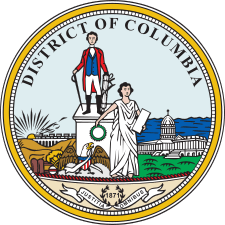Columbia Heights (Washington, D.C.)
Columbia Heights is a neighborhood in Northwest Washington, D.C., United States. Columbia Heights is known for its diversity,[1] housing stock,[2][3][4][5] major retailers,[6][7] "[a] splendid panoramic view of downtown DC,"[8][9] and a thriving restaurant scene.[10][11] In 2016, The Wall Street Journal recognized "Washington D.C.'s thriving Columbia Heights neighborhood."[12]
Columbia Heights | |
|---|---|
Neighborhood of Washington, D.C. | |
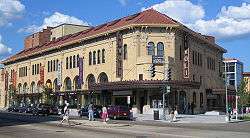 The Tivoli Theatre, a renovated landmark on 14th Street NW, is a symbol of Columbia Heights | |
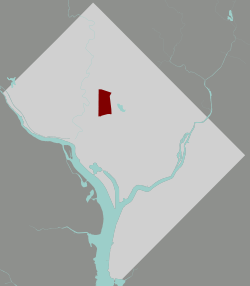 Columbia Heights within the District of Columbia | |
| Country | United States |
| District | Washington, D.C. |
| Ward | Ward 1 |
| Government | |
| • Councilmember | Brianne Nadeau |
| Area | |
| • Total | .85 sq mi (2.2 km2) |
| Population (2010) | |
| • Total | 31,696 |
| • Density | 37,289.4/sq mi (14,397.5/km2) |
In the early 1920s, jazz musician and composer Duke Ellington lived in Columbia Heights.[13] After turmoil during the 1970s and 1980s,[14] Columbia Heights has been cited as an example of "how a mixed-income, multiracial community can begin to stabilize."[15]
Geography
Located in the Northwest quadrant of Washington, D.C., Columbia Heights borders the neighborhoods of U Street Corridor (Cardozo/Shaw), Adams Morgan, Mount Pleasant, Park View, Pleasant Plains, and Petworth. On the eastern side is Howard University. The streets defining the neighborhood's boundaries are 16th Street to the west, Spring Road to the north; Sherman Ave to the east, and Florida Avenue to the south. It is served by the Columbia Heights station on the Yellow and Green lines of the Washington Metro.
History
19th century
Once farmland on the estate of the Holmead family (called "Pleasant Plains"), Columbia Heights was part of Washington County, District of Columbia. (It was within the District but outside the borders of the city of Washington; the southern edge of Columbia Heights is Florida Avenue, which was originally called "Boundary Street" because it formed the northern boundary of the Federal City.) In 1815 an engraver from England, William J. Stone, purchased a 121-acre tract of the Holmead estate—east of Seventh Street Road (present-day Georgia Avenue), and north of Boundary Street—and established his own estate known as the Stone Farm. Nearby, construction of the first building for Columbian College, now George Washington University, was completed in 1822 on the campus which was bounded by Columbia Road, 14th Street, Boundary Street (Florida Avenue) and 13th Street. The area began developing as a suburb of Washington soon after the Civil War, when horse-drawn streetcars delivered residents of the neighborhood to downtown.
The northern portion of modern-day Columbia Heights (i.e., north of where Harvard Street currently lies) was, until the 1880s, a part of the village of Mount Pleasant. The southern portion still retained the name of the original Pleasant Plains estate, though it was also known as "Cowtown."
In 1871, Congress passed the D.C. Organic Act, which eliminated Washington County by extending the boundaries of Washington City to be contiguous with those of the District of Columbia. Shortly afterward, in 1881–82, Senator John Sherman, author of the Sherman Antitrust Act, purchased the land north of Boundary Street between 16th Street and 10th Street, including the Stone farm, developing it as a subdivision of the city and calling it Columbia Heights in honor of the college at its heart. (The neighborhood's eastern, major traffic artery, Sherman Avenue, is named after its early developer.) Much of Sherman's purchase was land belonging to Columbian College.
The college had decided to move into the center of Washington's downtown business district and in 1904, changed its name to The George Washington University, in an agreement with the George Washington Memorial Association. By 1912 Columbian, now George Washington, relocated its major operations to Foggy Bottom. The federal government purchased some of the college's former land and built Meridian Hill Park in the early 20th century. The park, also known as "Malcolm X Park", contains many statues of historic international and United States figures, including Joan of Arc, Dante, and James Buchanan.
20th century
Upscale development in Columbia Heights circa 1900 was designed to attract upper level managers of the Federal government, U.S. Supreme Court justices, and high-ranking military officers. An imposing mansion known as "Belmont" marked the entrance to the neighborhood between Florida and Clifton Streets. The mansion was emblematic of the confidence that the affluent placed in the concept that Columbia Heights represented the ideal suburb. In the early 1900s, Columbia Heights was the preferred area for some of Washington's wealthiest and most influential people. Residents included authors Jean Toomer, Ambrose Bierce, Sinclair Lewis, Chief Justice Melville Fuller, and Justice John Marshall Harlan.
In 1901, the Commissioners of the District of Columbia renamed streets all over the District in accordance with a newly adopted street-naming system.[16] In Columbia Heights, Clifton Street, Roanoke Street, Yale Street, Princeton Street, Harvard Street, Columbia Road, Kenesaw Avenue, Kenyon Street, Dartmouth Street, and Whitney Avenue were renamed Adams Street, Bryant Street, Channing Street, Douglas Street, Evarts Street, Franklin Street, Girard Street, Hamlin Street, Hooker Street, and Irving Street, respectively.[16]

In 1902, there was a building boom in North Columbia Heights, with the expansion of the streetcar down 11th St, 14th St and 16th St. Homes were being built for between $2,000 and $5,000 and a total of five million dollars' worth of homes were being built.[18]
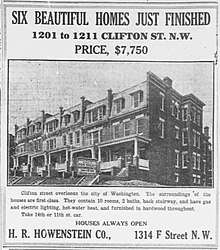
In 1904, the Columbia Heights Citizen's Association published an illustrated brochure entitled "A Statement of Some of the Advantages of Beautiful Columbia Heights." (PDF ) The publication describes Columbia Heights as a "residential section populated by public and spirited citizens." Residents at that time were "ever alive to the mental, moral, and spiritual advancements of their homes surroundings." The neighborhood organization sponsored competitions for landscaping house lots and offered prizes to the best kept lawn and garden, at the same time fought the erection of street poles and overhead telegraph and telephone lines. 1904 was also the year that Congress authorized changing the names of streets to align with the alphabetical and orderly naming convention of the Old City (i.e., below Boundary Street, now Florida Avenue). The name changes were put into effect the following year.[20]
By 1914, four street car lines served the section providing transportation to downtown Washington in twenty minutes. The neighborhood also became the home of the Washington Palace Five professional basketball team.

The popularity of the neighborhood resulted in the construction of several large apartment buildings during the beginning of the twentieth century that changed the suburban character of the area into a more urban and densely populated district. As of mid-century, however, Columbia Heights retained much of its upscale residential appeal, supporting establishments such as the ornate Tivoli Theatre movie house (completed in 1924). J.W. Marriott and his wife opened an A&W root beer franchise on 14th street in 1927, before creating the Marriott hotel chain.[22] The neighborhood was adjacent to Washington's thriving middle-class black community and came to be home to some of its most notable citizens by the 1930s. Duke Ellington, who had grown up in Shaw, purchased his first house at 2728 Sherman Avenue in Columbia Heights. Marvin Gaye briefly lived in the neighborhood and attended Cardozo Senior High School.
In 1949, during the era of racial segregation in the public schools, Central High School, a white high school that bordered the southern edge of Columbia Heights, did not have enough students. It was renamed as Cardozo High School and designated as a "colored" high school to accommodate the growing African-American population in the neighborhood. Significant demographic changes began in the late 1940s when African-American residents began to buy apartment buildings previously owned by whites, and in the 1950s blacks bought individual homes in ever increasing numbers. The neighborhood was a strong middle-class African-American enclave in Washington, along with the nearby Shaw neighborhood and Howard University, through the mid-1960s.
The neighborhood was featured in various clips, and as the home of protagonists Helen and Bobby Benson, in the 1951 film The Day the Earth Stood Still.
In 1968, following the assassination of Martin Luther King Jr., riots ravaged the 14th St. Corridor in Columbia Heights, along with the commercial U Street corridor nearby, and many other Washington neighborhoods to the east. Many middle-class residents moved out to the suburbs, resulting in a drop in business. As a result, many homes and shops remained vacant for decades. Some remaining residents could not afford to move, and struggled with problems of poverty and violence related to drugs. In addition to African Americans, the neighborhood had an increasing number of Latino immigrants and their descendants as residents.
Redevelopment and current day
In 1999, the city announced a revitalization initiative for the neighborhood focused around the Columbia Heights Metro station, which opened that year.[23]
There had already been positive developments along lower 14th Street and the U Street corridor.[24] The opening of the Metro station served as a catalyst for the return of economic development and residents. On March 5, 2008,[25] DC USA, a 546,000-square-foot (50,700 m2) retail complex across the street from the Columbia Heights Metro station opened. The space is anchored by retailers Target and Best Buy.[26] The shopping center also includes 390,000 square feet (36,000 m2) of underground parking.[27] Within five years, the neighborhood gentrified[28] considerably, with a number of businesses near the metro (including a Giant Food supermarket, Chipotle, CVS, Starbucks, Cava, Washington Sports Club, Bed Bath & Beyond, Petco and Tivoli Square, a commercial and entertainment complex). The Columbia Heights Farmers Market, located across the street from DC USA, provides neighborhood shoppers with locally produced food.[29] Pho 14 was an early Columbia Heights success story and was voted best pho in the Best of DC 2010 poll by the Washington City Paper.[30] Washingtonian magazine named Laotian restaurant Thip Khao one of the "100 Very Best Restaurants" of 2017.[31] Travel + Leisure wrote that "[t]hanks to Thip Khao, Laotian cuisine is having its day in DC."[32]
Unlike some gentrified neighborhoods in the city, Columbia Heights has not become homogeneous: "white, Asian, black and Latino residents each make up at least 10 percent of the population—and no group constitutes a majority."[1] It has been described as "a perfect little microcosm of D.C."[33] Housing includes high-priced condominiums and townhouses, as well as public and middle-income housing, and "even multi-million-dollar homes."[34] Developers in Columbia Heights have "watched it transform with dozens of new restaurants, shops and nightlife.[35]" In June 2017, Columbia Heights was listed as one of D.C.'s neighborhoods where home sellers get more than asking price.[36]
The 11th Street "Hip Strip"
The New York Times has called Columbia Heights' assortment of restaurants and bars on 11th Street Northwest, "Columbia Heights' Hip Strip."[37] It has also been called the "11th Street corridor."[38][39][40][41] Locals and observers have "described 11th Street as 'the social hub' of Columbia Heights."[42][43] Many bars and restaurants have opened along 11th Street[44]—some to great acclaim. Bistro and bar Room 11 is a "Columbia Heights mainstay"[45] and was part of a group of restaurants "shaping the arts and culinary landscape of the nation's capital."[46] President Obama visited 11th Street's The Coupe,[47] a combination bar, restaurant, and coffee shop, which has become "a one-stop destination for D.C. residents."[48] 11th Street wine bar and Italian restaurant, Maple, was named one of "America's Hottest New Wine Bars" by Details magazine.[49] Mexican eatery El Chucho, made The Washington Post's list of "essential eats,"[50] has "formidable mezcal collections"[51] and has an "Essential D.C. Rooftop."[52] Bar and restaurant Meridian Pint is "[t]he Columbia Heights craft beer destination"[53] with some of the District's best mac and cheese.[54] The Hill picked Meridian Pint as "Columbia Heights' most versatile new bar."[55] In 2016, Bon Appétit magazine named the Columbia Heights Filipino restaurant Bad Saint the No. 2 new restaurant in the United States.[56] The New York Times designated Bad Saint a "Critic's Pick," awarding it three stars and describing it as "one of Washington's most sought-after restaurants."[57] In 2019, Bad Saint's chef, Tom Cunanan, won the James Beard Award for Best Chef, Mid-Atlantic.[58]
11th Street is also home to the "Brooklyn-Inspired Corner Store," Odd Provisions, which carries some products made in Washington, D.C.[59] Comedian Patton Oswalt made a surprise appearance at 11th Street's Wonderland Ballroom,[60] which Travel + Leisure magazine honored for its "beer garden, a spacious patio with communal picnic tables, trees draped in twinkling lights."[61] 11th Street is also home to the arts & community center BloomBars, which "offers such varied events as independent film screenings, drum lessons, poetry readings, folkloric or belly-dance sessions, open-mike nights and yoga."[62] In 2017, Washingtonian magazine singled out 11th Street's Patrick's Pet Care for their annual list of "Washington, DC's Best Pet Care," noting its "emphasis on reliable and environmentally friendly pet services."[63]
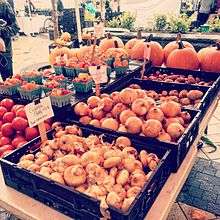
Demographics
The 2000 census figures estimated Columbia Heights with a 58 percent African-American population, including some African immigrants of the 20th century and later, and government and professional class; 34 percent Hispanic population; 5.4 percent white population; and 3.1 percent other.[65][66]
The 2010 census figures estimated Columbia Heights with a 43.5 percent African-American population, including government and other professional class; 28.1 percent Hispanic population; 22.9 percent White population; 3.2 percent Asian population; and a 2 percent Other population. In 2012, Columbia Heights was named one of the fastest gentrifying neighborhoods in the United States.[67]
Local institutions
In January 2005, the GALA Hispanic Theatre moved into the newly refurbished Tivoli Theatre as its first permanent home. This former movie theater, built in 1924, had been vacant since 1976. GALA is a theater company dedicated since the 1970s to performing Spanish-language plays.
In November 2006, the Dance Institute of Washington opened a new 12,000-square-foot (1,100 m2) facility across the street from the Tivoli Theatre.[68]
The neighborhood is also home to the Greater Washington Urban League, the local affiliate of the National Urban League, in addition to other non-profit community and service-based organizations including: The Latin American Youth Center, CentroNia, Central American Resource Center (CARECEN), and the Shaw/Columbia Heights Family and Community Support Collaborative, all located along the 14th St. and Columbia Road corridor.
The Ecuadorian embassy is located on 15th Street and the Mexican Cultural Institute on 16th Street. Located next door to the Mexican Cultural Institute is the former residence of the Ambassador of Spain. The Spanish Embassy is working to adapt the former residence as a cultural facility.[69] The Polish and Lithuanian embassies are also located on upper 16th Street, in this Columbia Heights section, as is the Cuban Embassy in Washington, D.C.
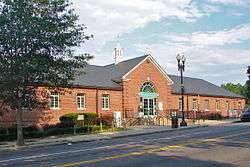
The Banneker Community Center, a unit of the District of Columbia Department of Parks and Recreation, contains playing fields, basketball and tennis courts, a swimming pool (Banneker pool), a computer lab and other indoor and outdoor facilities.[70] The center's main building was constructed in 1934 near Howard University and named for Benjamin Banneker. It was listed on the National Register of Historic Places in 1986 because of its important role in the development of the black community in Washington, D.C.[71]
In 2010, Washington Parks and People purchased the land between houses on 11th and Sherman Avenue in northwest D.C. near El Chucho, Red Rocks Pizza and Meridian Pint and created a community garden. The lot was purchased for $1 after Washington Parks and People worked tirelessly to remove the numerous liens on the property. The Columbia Heights Green continues to be supported by Washington Parks and People. Once a junk yard, the Columbia Heights Green is now a thriving community farm and community work days continue every Saturday. The garden was originally designed for individual plots, but is now set up with community beds.
The Columbia Heights Day Festival is a one-day street festival is a celebration of the diversity and community of Columbia Heights.[72]
Education
Residents are zoned to District of Columbia Public Schools.
Public schools in Columbia Heights include:
- High schools
- Cardozo High School
- Benjamin Banneker Academic High School
- Bell Multicultural Senior High School
- Booker T. Washington Public Charter School for the Technical Arts
- Middle schools
- Lincoln Middle School
- Elementary schools
- Bruce-Monroe Elementary School at Park View (Until 2008, two separate schools)
- Tubman Elementary School
- Public Charter Schools
- DC Bilingual Public Charter School
- AppleTree Early Learning Public Charter School
- Capital City Public Charter School
- Carlos Rosario International Public Charter School
- Children's Studio Public Charter School
- E. L. Haynes Public Charter School
- YouthBuild Public Charter School
- The Next Step Public Charter School
- Booker T. Washington Public Charter School for the Technical Arts
In popular culture
The 1993 film In the Line of Fire features a scene where a call from John Malkovich's character is traced to a building on Park Road. When Clint Eastwood's character and other police officers arrive on the street, they spot Malkovich walking past the Old Columbia Heights Firehouse and a chase ensues.
Klaatu, the alien in the 1951 film The Day the Earth Stood Still, played by Michael Rennie, boards in a house at 1412 Harvard Street for his stay in Washington.
Homeland TV series, S02E08
Notes
- "Residents in most diverse areas say their neighborhoods are better than others". The Washington Post. Retrieved 2017-02-20.
- "Seven new condos coming to D.C.'s Columbia Heights". The Washington Post. Retrieved 2017-02-21.
- Goldchain, Michelle (2017-01-30). "Apartment building in Columbia Heights' 11th Street Corridor sells for $3.25M". Curbed DC. Retrieved 2017-02-22.
- "Home Price Watch: The High Volume Market of Columbia Heights". UrbanTurf. Retrieved 2017-02-22.
- "Where condo sales are hottest in D.C." The Washington Post. Retrieved 2017-02-22.
- Sirota, Stu (2011-05-24). "EnvisionBaltimore: 20-Minute Neighborhood Spotlight: Columbia Heights". EnvisionBaltimore. Retrieved 2017-02-21.
- "www.bizjournals.com/washington/news/2016/11/30/new-artisanal-market-for-columbia-heights.html". www.bizjournals.com. Retrieved 2017-02-22.
- "Cultural Convergence: Columbia Heights Heritage Trail - www.culturaltourism.org". www.culturaltourismdc.org. Retrieved 2017-02-21.
- Paschall, Valerie. "The Nine Best Views in Washington D.C." Curbed DC. Retrieved 2017-02-26.
- Ramanathan, Lavanya; Ramanathan, Lavanya (2016-11-14). "In the hot D.C. dining scene, the allure of the power restaurant is waning". The Washington Post. ISSN 0190-8286. Retrieved 2017-02-22.
- Knowlton, Andrew. "Washington D.C. Is the Restaurant City of the Year". Bon Appetit. Retrieved 2017-02-22.
- Rodbard, Matt. "Filipino Cooking Has (Finally) Arrived On The Scene". WSJ. Retrieved 2017-02-21.
- Catlin, Roger; Catlin, Roger (2012-01-20). "Duke Ellington's Washington". The Washington Post. ISSN 0190-8286. Retrieved 2017-02-22.
- "In 1979, was your neighborhood "sound" or "distressed"?". Retrieved 2017-02-22.
- Brown, Stephanie (July 2014). "Beyond Gentrification: Strategies for Guiding the Conversation and Redirecting the Outcomes of Community Transition" (PDF). Harvard’s Joint Center for Housing Studies and NeighborWorks America.
- "Streets Named Anew: Commissioners Fix Highway Nomenclature for Suburbs". The Washington Post. August 15, 1901. p. 2. ProQuest 144270485.
- Tom (2013-09-30). "1903 Map of a Very Undeveloped Columbia Heights". Ghosts of DC. Retrieved 2019-02-25.
- "Street Car Extensions and a Columbia Heights Building Boom (1902)". Ghosts of DC. Retrieved 10 January 2012.
- Tom (2015-10-22). "1910 Ads for Clifton St. Homes in Columbia Heights". Ghosts of DC. Retrieved 2019-02-25.
- "Old Columbia Heights: Where the Streets Have New Names". Ghosts of DC. Retrieved 19 April 2012.
- Tom (2014-07-31). "What Did Columbia Heights at 14th and Irving Look Like in the 1920s?". Ghosts of DC. Retrieved 2019-02-25.
- "Neighborhoods: A look at Columbia Heights, Washington DC". WTOP. 2015-03-10. Retrieved 2017-02-23.
- "Washingtonpost.com: Metro Goes to New Heights in District". www.washingtonpost.com. Retrieved 2017-02-20.
- "Amid gentrification, a 'new' D.C. emerges". Inman. Retrieved 2017-02-20.
- "The Target is Open! The Target is Open!" Archived 2008-03-08 at the Wayback Machine, dcist.com, March 5, 2008
- DC USA at Columbia Heights News, accessed 2007-09-26
- DC USA Archived 2007-09-15 at the Wayback Machine, Bower Lewis Thower Architects
- "Defining, Debating And Defending Gentrification". www.wbur.org. Retrieved 2017-02-26.
- "USDA Blog » Local Food – Cooking Up Creative & Fresh Ideas for Healthy Communities". blogs.usda.gov. Retrieved 2017-02-21.
- "Reader Poll: D.C.'s Best Pho 2010 - Washington City Paper". Washington City Paper. Retrieved 2017-02-21.
- "100 Very Best Restaurants 2017: Bangkok Golden/Thip Khao - DC Restaurant | Washingtonian". Washingtonian. Retrieved 2017-02-22.
- "The Best Cheap Eats in Washington, D.C." Travel + Leisure. Retrieved 2017-02-22.
- "The Good Silver Replacing Kangaroo Boxing Club in Columbia Heights". Eater DC. 2017-03-15. Retrieved 2017-03-18.
- Goldchain, Michelle (2016-03-23). "Here are Columbia Heights' 5 Most Expensive Homes". Curbed DC. Retrieved 2017-02-20.
- "A condo complex in Columbia Heights where no apartment feels the same". The Washington Post. Retrieved 2017-02-20.
- "Where DC home sellers get more than asking price". WTOP. 2017-06-20. Retrieved 2017-07-17.
- "In Washington, D.C., Columbia Heights' Hip Strip - Slide Show - NYTimes.com". www.nytimes.com. Retrieved 2017-02-20.
- "Living LivingSocial". Washington City Paper. Retrieved 2017-02-23.
- Brandon Wetherbee (2012-10-02). "LOOK: A New 24-Hour Roost For Night Owls In Columbia Heights". The Huffington Post. Retrieved 2017-02-23.
- "Condos in Northwest Washington have a roomy feeling and the amenities". The Washington Post. Retrieved 2017-02-23.
- Goldchain, Michelle (2017-01-30). "Apartment building in Columbia Heights' 11th Street Corridor sells for $3.25M". Curbed DC. Retrieved 2017-02-23.
- Goldchain, Michelle (2016-04-12). "A Local's Guide to Columbia Heights". Curbed DC. Retrieved 2017-02-20.
- http://www.washingtontimes.com, The Washington Times. "Neighborhoods: A look at Columbia Heights, Washington DC". The Washington Times. Retrieved 2017-02-21.
- "The Emerging Restaurant Scene on 11th Street". UrbanTurf. Retrieved 2017-02-22.
- "Things to Do in DC this Weekend: "Star Wars" Day at Nats Park, the 14th Street Burger Battle, and a Hank the Cat Documentary". Washingtonian. 2016-08-11. Retrieved 2017-02-20.
- Wildman, Sarah; Wildman, Sarah (2017-01-25). "How a mother-and-son duo shaped Washington's art and food scenes". The Washington Post. ISSN 0190-8286. Retrieved 2017-02-20.
- "How the Obamas Changed Washington". Washingtonian. 2016-12-04. Retrieved 2017-02-21.
- Brandon Wetherbee (2012-10-02). "LOOK: A New 24-Hour Roost For Night Owls In Columbia Heights". The Huffington Post. Retrieved 2017-02-21.
- "Details Magazine". October 2012.
- Ramanathan, Lavanya; Ramanathan, Lavanya (2013-01-25). "Time to dish: What are D.C.'s 40 essential eats?". The Washington Post. ISSN 0190-8286. Retrieved 2017-02-21.
- "Mezcal Takes the Limelight at Shaw's Espita Mezcaleria". Washington City Paper. Retrieved 2017-02-21.
- Bethune, Meredith. "15 Essential D.C. Rooftops for Drinking and Dining". Eater DC. Retrieved 2017-02-26.
- Hahn, Fritz; Hahn, Fritz (2015-10-29). "Craft beers meet arcade games in Meridian Pint's basement". The Washington Post. ISSN 0190-8286. Retrieved 2017-02-21.
- "Where to Find D.C.'s Best Gooey, Indulgent Mac and Cheese". DCist. Archived from the original on 2017-02-26. Retrieved 2017-02-26.
- Perks, Ashley (2010-09-30). "Meridian Pint, Columbia Heights' most versatile new bar, can cure your 'ales'". TheHill. Retrieved 2017-02-21.
- Knowlton, Andrew. "Bad Saint Is the #2 Best New Restaurant in America 2016". Bon Appetit. Retrieved 2017-02-20.
- Wells, Pete (2016-11-29). "Filipino Food Worth the Wait at Bad Saint in Washington". The New York Times. ISSN 0362-4331. Retrieved 2017-02-20.
- Spiegel, Anna (May 6, 2019). "Two DC Chefs Win Big at the 2019 James Beard Awards". Washingtonian Magazine.
- 28, Jessica Sidman on November; 2016 (2016-11-28). "Room 11 Vets Open a Brooklyn-Inspired Corner Store with DC Products". Washingtonian. Retrieved 2017-02-20.CS1 maint: numeric names: authors list (link)
- "Underground Comedy surprises DC with Louis CK, Patton Oswalt". WTOP. 2017-02-06. Retrieved 2017-02-20.
- "Washington, D.C. Tour: Mount Pleasant/Columbia Heights". Travel + Leisure. Retrieved 2017-02-20.
- Simmons, Holley; Simmons, Holley (2015-06-04). "Street Smart: Exploring Columbia Heights". The Washington Post. ISSN 0190-8286. Retrieved 2017-02-21.
- "Washington, DC's Best Pet Care: Patrick's Pet Care". Washingtonian. 2017-02-02. Retrieved 2017-02-26.
- "Home". Community Foodworks. Retrieved 2017-02-21.
- "DC ANC Profile - NeighborhoodInfo DC". Archived from the original on 2007-02-10. Retrieved 2007-01-25.
- demographics
- "Report: D.C. white population grown rapidly in 3 ZIP codes". WJLA. Retrieved 1 August 2012.
- Dance Institute of Washington Archived 2007-10-04 at the Wayback Machine, Cultural Tourism DC.
- The Spain-USA Foundation
- (1) "Banneker Community Center". District of Columbia Department of Parks and Recreation. Archived from the original on 2010-11-27. Retrieved 2012-09-11.
(2) "Banneker Pool". District of Columbia Department of Parks and Recreation. Archived from the original on 2013-06-09. Retrieved 2012-09-11. - Friedlander, Bernice; Bowers, Martha: Louis Berger & Associates, Inc., Washington, D.C. (1984-08-31). "National Register of Historic Places Inventory — Nomination Form: Banneker Recreation Center" (PDF). United States Department of the Interior: National Park Service. Archived from the original (pdf) on 2012-09-11. Retrieved 2012-09-11.
- "Columbia Heights Day Festival 2016 – COHI DC". www.cohiday.org. Retrieved 2017-02-21.
External links
| Wikimedia Commons has media related to Columbia Heights, Washington, D.C.. |
| Wikivoyage has a travel guide for Columbia Heights (Washington, D.C.). |

